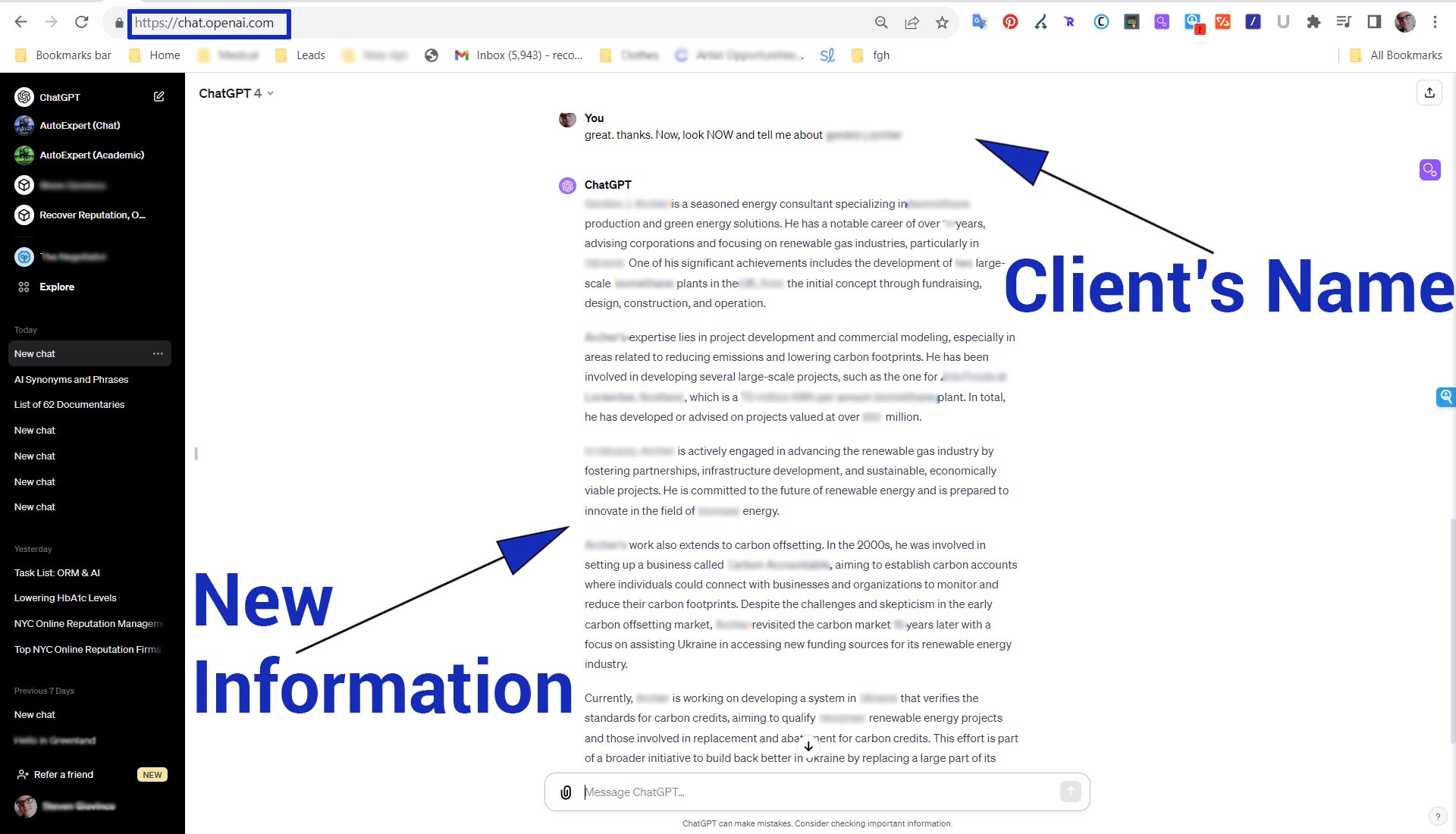Last Updated on August 2, 2023 by Steven W. Giovinco
Original photos taken and edited by the author.
Online Reputation Strategies for Businesses to Avoid Greenwashing and Foster Sustainable Practices
Key Points:
- Businesses exaggerate their environmental efforts in the deceptive practice ‘greenwashing’ to appear more sustainable.
- Greenwashing can damage a company’s online reputation, leading to loss of consumer trust, negative publicity, potential legal consequences.
- Online reputation management can repair greenwashing.
Buyers want to buy “green”. In the era of conscious consumerism these days, many businesses are trying to signal their commitment to the environment and sustainability in a bunch of ways. However, not all are really eco-friendly.
As a result, ‘Greenwashing’ is somewhat rampant, and is the term used for the deceptive practice where companies exaggerate or falsify their efforts to appear more sustainable than they really are. I’ll delve deeper into greenwashing, its reputation implications, and how consumers and businesses can navigate this deceptive landscape.
What Is It
Greenwashing is a seemingly benevolent but false tactic where a corporation, business, or brand presents itself as more environmentally friendly than they are. This can come in various forms, each designed to create a false impression of sustainable responsibility.
Where it Started
First, let’s examine the term. “Greenwashing” was coined by environmentalist Jay Westerveld back in a 1986 essay, where he criticized the hotel industry’s practice of placing placards in each room suggesting the reuse of towels to essentially “save the environment”. But in most cases, little or no effort toward waste recycling was being used by these businesses. Westerveld discovered that the actual objective of this “green campaign” was to make more money (shocking!). He labeled this tactic to maximize profits as greenwashing.
The Many Forms of Greenwashing
Ambiguous Language
Commonly, greenwashing uses vague or suggestive language. Companies might mention terms like ‘green’, ‘eco-friendly’, ‘natural’, or ‘sustainable’ without defining what they are really talking about. For instance, a product might be labeled as ‘all-natural’, but since it has no standard definition, it can be used to describe nearly anything.
Misleading Labels
Another form of greenwashing is the use of misleading labels. A business might create a label or logo that looks like an environmental certification, even though it has no official standing to back it up. Or, a company might use a legitimate certification deceptively, such as by placing it prominently on a webpage when only a small part of the product/service meets that criterion.
False Advertising
False advertising is a more blatant form of greenwashing. This involves making false, unreal or unsubstantiated claims about environmental benefits. For example, a company might claim that its service is ‘carbon-neutral’ or ‘zero-waste’ without providing any evidence to back this up.
Lack of Transparency
Simply omitting facts can also be a form of greenwashing. A company might make very broad claims about its environmental commitment without being transparent about its actual practices. For instance, they might claim to be ‘committed to sustainability’ without providing any detailed information about their carbon footprint, waste management practices, or sourcing policies.
Deceptive Imagery in Greenwashing
Imagery plays a powerful role in shaping perceptions and influencing behavior. In the context of greenwashing, companies often exploit this to create a fake impression of environmental responsibility. This tactic is prevalent and can be hard to spot.
Lush green landscapes, clean rivers, and nature-related images often appear in a business’s products or in its advertising. These evoke feelings of serenity, purity, and harmony with nature, leading buyers/consumers/clients to associate positive feelings with the company or product. This can create the idea that they are environmentally friendly and care about the planet.
However, these images often mask the reality of the company’s environmental record. For example, a financial company might use images of a pristine forest throughout its branding, even though the services they promote contribute to deforestation. Or, a company might use photos of clean water in its advertising, even though it discharges pollutants into local rivers.
Also, the deception of imagery can make it difficult for consumers to make the right choice, especially as AI becomes more prevalent. It can be confusing and make it harder for people to distinguish between companies that are genuinely sustainable and those that are merely greenwashing.
Social media allows the swift sharing of images, making deception a powerful tactic. However, as people become more aware, companies that engage in it risk damaging their online reputation and losing consumer trust.
False Accusations
Competitors attempting to gain a competitive edge may resort to spreading false rumors or information about a business’s environmental practices. They could allege that the company is not following regulations, is harming the environment, or is not genuinely committed to its initiatives. These false claims can quickly spread online through social media platforms, blogs, and review sites, harming the company’s online reputation and potentially leading to lost business and more.
Disgruntled ex-employees can also threaten a company’s online reputation. Given their insider knowledge and potential access to sensitive information, they could make false claims about the company’s environmental practices out of spite or to retaliate. These can be particularly damaging since they appear credible due.
So, greenwashing can take many forms, all designed to mislead consumers and create a false impression of environmental responsibility. It’s important for consumers to be aware of these tactics and to scrutinize environmental claims carefully.
Examples of Greenwashing
Several high-profile greenwashing cases have come to light in recent years. Here are some examples.
BP (British Petroleum)
Back in the early 2000s, BP, one of the world’s largest oil and gas companies, launched a $200 million advertising campaign to rebrand itself as “Beyond Petroleum”. The idea was to portray the company as a forward-thinking corporation committed to renewable energy. The rebranding included a new logo, and a green and yellow sunburst, illustrating clean energy.
However, only a small portion of their total investment outlay was in renewable energy. It seemed that the rebranding was just a tactic designed to distract from the company’s continued dependence on oil.
BP’s reputation took a further hit with the Deepwater Horizon oil spill in 2010, one of the worst environmental disasters in history. The incident released millions of barrels of oil into the Gulf of Mexico, causing untold harm to marine and wildlife habitats and the Gulf’s fishing and tourism industries. The disaster once again revealed the gap between BP’s environmental claims and its actual practices, causing significant damage to its reputation.
H&M
H&M, a leading fast-fashion retailer, has been accused of greenwashing through its “Conscious Collection”, which claims to use sustainable materials. The collection is marketed as environmentally friendly, with items made from organic cotton and recycled materials.
However, promoting sustainable clothing lines distracts from the unsustainable nature of fast fashion. Fast fashion is characterized by quick turnaround times from design to production to retail, encouraging overconsumption and leading to massive waste. Despite H&M’s claims of sustainability, they produce large quantities of inexpensive, low-quality clothing that contributes to global waste.
Nestlé
Nestlé, the world’s largest food and beverage company, has been accused of greenwashing for its claims about palm oil. In 2010, the company pledged to use only “sustainable palm oil” in response to a Greenpeace report that linked the company to deforestation.
Despite its stated pledge, Nestlé continues to get palm oil from suppliers implicated in deforestation and peatland destruction, both of which contribute to climate change. These practices have led to accusations of greenwashing and have damaged Nestlé’s reputation.
Fiji Water
Fiji Water, a popular brand of bottled water, faced criticism for its environmental claims. The company markets itself as environmentally responsible, touting its commitment to climate neutrality and the use of environmentally friendly packaging. Fiji Water claims that it offsets its carbon emissions through various initiatives, including a reforestation project in Fiji.
However, these distract from the significant environmental impact of the packaged water industry. The process of bottling and shipping water involves extracting water from natural sources, bottling it in plastic containers, and then shipping it to consumers around the world. Each of these stages has an environmental cost.
Despite claims of climate neutrality, the company contributes to resource depletion, pollution, and climate change. While their environmental initiatives certainly seem commendable, they probably do not offset the environmental impact of the bottled water industry. These criticisms have led to accusations of greenwashing and have raised questions about the company’s environmental reputation.
These examples illustrate how greenwashing can backfire and damage a company’s reputation. Consumers and regulators are becoming increasingly vigilant about holding companies accountable for their environmental claims.
Negative Consequences of Greenwashing on Online Reputation Reputation
A company’s online reputation is more than just its website, reviews, and Facebook posts; it’s a reflection of the company’s credibility, trustworthiness, and overall image. It drives consumer decisions, affects sales, and even impacts the company’s ability to attract and retain top talent. Yet greenwashing can severely damage a company’s online reputation, leading to a cascade of damaging consequences.
Loss of Consumer Trust
Trust is a key between consumers and businesses. When a company’s environmental claims are discovered to be untrue or misleading, it can lead to a significant loss of consumer trust. Consumers who feel deceived might switch to competitors and discourage others from supporting the business. This loss of trust can be particularly damaging in the era of social media, where negative experiences can be shared widely and quickly.
Negative Publicity
Greenwashing can also lead to negative publicity, of course. News of a company’s deceptive environmental claims can spread rapidly online, attracting attention from media outlets, influencers, and the general public. This negativity tarnishes the company’s online reputation.
Legal Consequences
In some cases, greenwashing can lead to legal problems. Companies that make false or misleading environmental claims can face fines, lawsuits, and other actions, especially in the EU. These legal issues can be costly and time-consuming, and they can cause further damage to the company’s online reputation.
Impact on Employee Morale and Recruitment
A company’s online reputation can also affect its ability to attract and retain employees. Many want to work for companies that align with their values, including environmental sustainability. If a company is found to be greenwashing, it can harm employee morale and make it harder to attract top talent.
Steer Clear of Greenwashing: A Guide for Ethical Business Practices
To avoid greenwashing, businesses, brands, and CEOs should be honest. Strive for transparency, authenticity, and consistency in environmental claims and practices. This includes being truthful about their environmental impact, avoiding misleading claims or imagery, and making a genuine commitment to improving their environmental performance.
Since clients are increasingly conscious of the environmental impact, businesses need to show their commitment to sustainability. However, it’s crucial to avoid greenwashing.
Here are some strategies that need to be used to avoid greenwashing.
Transparency
One of the key ways to avoid greenwashing is to just be truthful. This means being open about the environmental impact of operations and services. If a business is making progress towards sustainability, share its journey, including the challenges and trade-offs they face. If they’re not as green as they’d like to be, acknowledge it and share ideas for improvement. Transparency can help build trust with consumers and stakeholders, and it can also help you avoid being called out for greenwashing.
Authenticity
Authenticity is another crucial aspect of avoiding greenwashing. This means ensuring that your environmental claims are backed by facts and actions. Don’t make unsubstantiated claims, and avoid using vague or misleading language. Authenticity also means being true to your brand and your values. If sustainability is a core part of your brand, make sure this is reflected in all aspects of your business.
Consistency
Consistency is also important in avoiding greenwashing. This means being consistent in your environmental claims and practices. If they are already sustainable, reflect this in everything that is done, from services to marketing and communications. Consistency can help build credibility and trust with consumers and stakeholders.
Commitment to Improvement
Finally, avoiding greenwashing requires a genuine goal of improving poor environmental performance. This means continually looking for ways to reduce your environmental impact and investing in sustainable practices. It also means being open to feedback and willing to make changes if and when necessary. A commitment to improvement shows that you take sustainability seriously and are not just using it as a marketing tactic.
By following these strategies, businesses can both avoid greenwashing and also contribute to a real sustainable future. It’s important to remember that sustainability is not just about avoiding harm but also about creating positive change. Businesses have a crucial role to play in this, and those that embrace this role can reap significant benefits, including enhanced brand reputation, increased customer loyalty, and improved business performance.
Leverage Online Reputation Management to Rectify Greenwashing Practices
Here are some ways to implement, build and repair an online reputation due to greenwashing.
Online Reputation Repair
If a company has been accused of greenwashing, it’s crucial to repair its online reputation as soon as possible. This involves addressing the issue head-on, apologizing if necessary, and outlining the steps the company is taking to rectify the situation. Publish these actions through blog posts, articles, videos, presentations, and photos. Be authentic when connecting to followers online and be mindful of any issues that could come up.
Online Reputation Building
Crafting a positive online reputation is one of the best defenses against accusations of greenwashing. This involves consistently showing the company’s commitment to sustainability through its actions and communications. It also involves actively promoting the company’s sustainability initiatives and achievements online. Make sure your website reflects this, along with any future content. A strong online reputation can help to build trust with consumers and stakeholders, making it less likely that the company will be accused of greenwashing.
Image Reputation
Images have a significant impact on a company’s online reputation. Be ensure that the company’s images reflect its commitment to sustainability and do not contribute to greenwashing. This might involve using real images that show the company’s environmental practices, or it might involve avoiding images that are misleading or deceptive.
Reputation Removal
In some cases, it may be possible to remove negative content that is damaging the company’s online reputation, especially if it’s created by a disgruntled ex-employee or someone trying to post false information. This could involve working with a reputation management company to request the removal of negative content from search engine results or social media platforms. However, it’s important to remember that reputation removal should be used as a last resort and is not ever a substitute for addressing the underlying issues that led to the negative content in the first place.
Bottom Line
Greenwashing is a misleading tactic that can inflict damage on a company’s online (and offline) reputation. There are countless instances where brands have tried deceitful strategies, only to be exposed, resulting in a tarnished reputation. The ‘cure’ lies in embracing transparency, authenticity, and proactivity, which fosters trust among consumers, bolsters the company’s reputation, and propels marketplace success. The fundamental principle, applicable to all situations, remains: be honest.
Related posts:
- Online Reputation Management Is Like Being at a Cocktail Party
- 4 Reasons Why Blogs Are Crucial for Online Reputation Management and Repair
- How Facebook and Cambridge Analytica Could Impact Your Online Reputation
- Recover Reputation’s Plans for 2023: Give Away More Information and Offer Pro Bono Services



